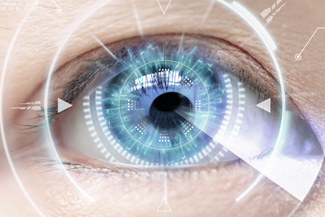Vision Problems After LASIK Or Other Refractive Surgeries
Everyone who has LASIK or other refractive surgeries, expects great results. Some, however, have had outcomes that are less than ideal and search for answers to restore their vision. If your results were less than what you were hoping for, we may have answers to some or all of your problems and help you restore vision.
Fortunately, LASIK has a relatively good track record, but no procedure will help everyone 100% of the time. Custom Gas Permeable (GP), Scleral, Semi-Scleral, or hybrid contact lenses often give relief and improve vision. This is especially true if a follow-up surgical procedure, euphemistically called an enhancement, is not possible.
The sharper clarity of a GP lens can correct optical imperfections that eyeglasses and soft contacts can't address. This makes gas permeable contact lenses or hybrid lenses a better choice if you're looking to restore the sharpest vision possible.
The results of LASIK and other laser vision correction procedures depend on the skill of the surgeon as well as how your corneas heal. Symptoms that some people have after laser procedures include glare, halos, and starbursts around headlights and streetlights. LASIK and other procedures also can sometimes cause irregular astigmatism, with accompanying blurred and/or distorted vision. Fortunately, for most people who have a less-than-perfect vision after refractive surgery, these problems are quite mild and usually tolerable. For others, however, the vision problems that occur after surgery can cause eye strain, headaches and difficulty driving at night.


If you are reading this, you are probably one of those people that are bothered by the results. LASIK and other laser vision correction procedures reshape your eye's front surface by removing microscopic amounts of tissue from the cornea. This can cause irregularities in the shape of the cornea that can make your vision less distinct after surgery than it was when you wore glasses or contact lenses before the procedure.
Gas permeable contact lenses create a new optical surface on the eye and enable you to see more clearly. Soft lenses simply conform to the shape of the cornea. A "lake" of tears covers irregularities on the cornea's surface that cause irregularities and the blurred vision. The clear front surface of the GP lens optically replaces the irregular corneal surface, eliminating blur and visual distortions.
A common complication of LASIK is dry eye. Soft lenses can cause dry eye. Therefore wearing a soft lens after LASIK may make the dry feeling even worse. Regular eyeglasses can’t undo the corneal irregularities caused by LASIK.
Prescribing contact lenses after refractive surgery is more time-consuming than regular contact lens fittings because the cornea has been altered. It requires special skills similar to those needed to fit lenses irregular-shaped corneas caused by keratoconus or a cornea transplant. Our optometrist near East Brunswick, NJ uses a Corneal Topographer, a special computerized instrument that obtains highly accurate, point-to-point measurements of the post-surgery corneal surface so we can see exactly where the cornea is irregular. Lens modifications may be needed to arrive at the best vision, comfort, and positioning of the lens. Dr. Roth specializes in prescribing contact lenses for even hard-to-fit-eyes.
Scleral lenses and Hybrid contact lenses may give you the sharpness that you are looking for. Hybrid contact lenses have a rigid GP lens in the middle with a soft skirt for comfort. They are designed to offer the best of both worlds: aberration-correcting optics of a rigid GP lens and wearing comfort that is comparable with soft contact lenses.


